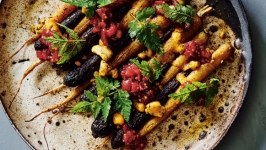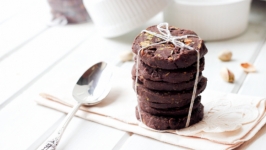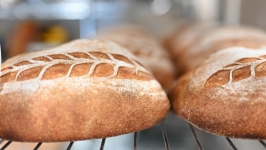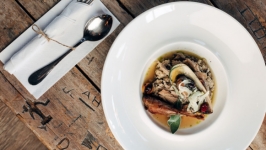The World is Your Dumpling
Wikipedia's vague description leaves it up to the reader’s imagination: Dumplings are a “broad classification for a dish that consists of pieces of dough (made from a variety of starch sources) wrapped around a filling, or of dough with no filling.” As frustratingly interpretable as that may be, there’s comfort in a culturally transcendent dish. Everyone the world over loves fried, steamed or boiled dough balls, filled, or not filled, with sweet or savoury things. It’s a struggle to try and think of a culture that doesn’t have something that either falls into this category or at least an adjacent culinary subsection.
Often our minds go directly to Asian influences: thin wontons in a delicate umami-laden broth, or half-moons of crispy pan-fried Japanese gyoza. This little eat-by-the-boatload delicately wrapped and folded bites of pork, chive and shrimp are synonymous with dim sum brunch or a dish one might have before a feed of ramen.
Dumpling? Dumpling! in Ottawa’s Centrepointe neighbour- hood, opened in February 2018 and makes traditional dumplings by hand. The dumpling-makers are front and centre, folding and twisting hundreds of dumplings a day in full view of the restaurant’s growing neighbourhood and college-based clientele. As its name implies (twice), staff members don’t mess around when it comes to making these small pockets of flavour. They offer a plethora of meat- or veg-based dumplings and your choice of cooking method: pan- or deep-fried, steamed or boiled. The first location’s success has allowed the owners to start working on a downtown Bank Street location set to open in the spring.
Dumplings as a side-hustle
Chī Dumplings owner Shuai Song has cooked professionally for the past four years, mainly at pasta-focused restaurants Supply and Demand, as well as North & Navy. She pursues her dumpling-making on the side, for at-home enjoyment or pop-up shops and markets.
There’s no doubt that Song’s pasta-rolling days have impacted her dough-rolling abilities, though her passion for dumplings was instilled early on, while making them with her grandmother through her elementary school days in Tianjin, China.
History places China as the birthplace of dumplings. The documentary record (and legend) puts Zhang Zhongjing, a Chinese pharmacologist, in the driver’s seat. Allegedly, in the dead of winter, he stretched lamb with spices and medicinal herbs, filled dough wrappers with the combination, and served them to frostbitten and sick locals, thus creating the dumpling.
Song’s understanding of their history starts them out as something of a half-moon shape that has evolved throughout China’s own unending evolutions. Shapes and styles of the dumplings are based on stories and legends, though their physiology is constant: a soft dough, rolled out thinly and filled, then closed with well- spaced folds. Song points out that this serves two purposes; it “not only looks beautiful, but it prevents them from breaking in the water.” There’s nothing more tragic than boiling or pan-frying a dumpling, only for it to spill its precious cargo.
The essence of dumplings
Since their initial appearance in the historical record (and probably well before), dumplings have existed in one capacity or another. A dough made out of local grains would be cooked in a variety of methods and then filled — or not. This is a culinary baseline for any civilization. Dumplings are, in essence, a rudimentary dish meant to extend and stretch any produce or protein in a delicious and warming manner.
Over the two-plus millennia of dumpling history, they’ve evolved little. In our modern era, "elevated" dumplings can be found on many menus throughout the city. Ingredients span the cultural zeitgeist; Big Mak gyoza exists at Roku, as does North & Navy’s roasted corn ravioli with Nordic shrimp and pancetta. House of Targ, the music hall and pinball haven in Old Ottawa South, boasts a plethora of pierogies, from traditional cheese to pizza pocket, as well as a Montreal-smoked-meat iteration aptly named Use the Schwartz.
I asked some colleagues for their thoughts on what defines a dumpling. Chef Drew Fraser suggested that the dumpling’s omnipresence is due to its simplicity and commonplace ingredients: a simple base of flour and water that is fried or simmered in broth. Anything else on hand was added in to achieve a full belly. As the Oxford Companion to Food puts it, “a dumpling is a food with few, indeed no, social pretensions.” Dumplings are for the people.
Dessert dumplings
Dumplings are no stranger to the dessert course either. Historically speaking, these would be filled with fruit and perhaps a sweetening component such as honey. Simplicity was everything. North America’s addition to the world of dumplings would be the apple dumpling: a fairly large pastry, filled with a full apple, spices and butter. On paper, a case can be made for donuts as dumplings. They’re big, fried, sweet dough balls, though they usually involve yeast — and most dumplings remain unleavened. As a nascent dumpling connoisseur, I won’t go so far as to say donuts really are dumplings, but I have to note that the opinion holds in some corners.
This especially rings true when considering the first dumpling — let’s call it Dumpling Zero. In ancient times, yeast had not yet been discovered. Leavening was not a regular process, and the idea of waiting even longer for a food made no sense. A simple, thin dough wrapper or ball would have been the norm — and yeast, at least a few centuries ago, an elbows-out interloper.
SuzyQ Doughnut’s Jesse McDonald was apolitical about the status of donuts as dumplings. McDonald deems donuts at least dumpling-adjacent: “Many cultures have made little bits of dough with fillings or adornments into different types of treats and finger foods.” SuzyQ’s munkki donuts — Scandinavian, yeast-raised cardamom-forward rings of fried goodness — merit, if nothing else, an honorary mention. McDonald and his staff are always ready to push the boundaries and flavours forward: “I would absolutely not rule anything out... You definitely want to be watching SuzyQ. We’re on your team.”
So what is a dumpling? As the idiom goes, “close only counts in horseshoes and hand-grenades.” But I’d like to amend that to add, “and also dumplings.” In researching and talking to folks for this article, it became increasingly clear that there is no single rule, regulation or distinction for a dumpling. And why should there be? We’re talking about a simple flour-based dish cooked in a multitude of ways, with or without stuff inside it. Not only is that confusingly ambivalent, but it’s been invented and reinvented the world over since the days we turned grain into flour.
There cannot be a singular approach to an infinite delight. Rather, we should embrace the dumpling and its expansive family for all it can offer us. Dough. With things in it. For many of us, not just a food, but a prime source of table-side heaven.












